I’ve been pretty pleased with the way the random selection of countries has gone thus far. Sooner or later, I’m bound to draw neighboring countries back-to-back or stay on the same continent for a month, but starting off with five weeks in five completely different regions of the world has made this project especially fun. So, having gone from Western Africa to the Middle East to Central America to East Asia, this week, we’re in Eastern Europe. And having stuck with mostly entrees and savory foods thus far, it’s time to get a little bit snacky and a little bit sweet.
Incidentally, besides introducing me to tasty new foods, this project has already helped improve my knowledge of geography, too. I was less than completely sure of Honduras’s location before looking it up a couple of weeks ago (I knew it was one of the countries in the middle of Central America, but I couldn’t have told you with any certainty which outline on the map belonged to Honduras and which one belonged to Nicaragua), but now I know both where it is and at least a little bit of its culture and history. I was even less certain of Moldova’s location when I drew it this week – in fact, I’d say the sum total of my knowledge of Moldova a week ago consisted of “it’s somewhere in Eastern Europe, and I think it’s had problems of some sort that have made the news in recent years? Also, it may or may not be the same thing as Moldavia?” (Turns out it’s not exactly the same thing as Moldavia, which was a principality in the same general region (and named after the same river) that ceased to exist roughly 150 years ago, but a lot of people still seem to use “Moldavian” to mean “Moldovan,” which explains my confusion.) But hey, now I know where Moldova is (it’s in between Romania and Ukraine) and why they’ve been in the news (a rather depressing assortment of problems, most notably including the fact that the local banks “lost” a billion dollars in 2014, where “lost” means “oops, it seems to have fallen directly into the pockets of one or more very wealthy, very powerful, very terrible people”). And more importantly – at least for the purposes of this project – I now know how to make plăcintăs.
(A side note: I actually made two things again this week, but the first one (mamaliga, or Moldovan polenta, which I tried preparing baked with cheeses and herbs) turned out neither interestingly good nor interestingly bad, but just blandly mediocre. I think my main mistake was trying to make a reduced-sodium version of it; there are lots of yummy dishes in the world with minimal salt content, but this didn’t happen to be one of them. On top of the fact that the resulting dish was less than interesting, my cell phone freaked out that day and consistently refused to take pictures in focus, so all I would have had for you is instructions on how to make tolerably okay-ish food accompanied by pictures of blurry yellow blobs. Under the circumstances, I’m going to skip that and cut straight to the plăcintăs.)
Plăcintăs, or plăcintă cakes, are an old, old recipe – or at least a modernized version of an old, old recipe. The name derives from the Latin word “placenta,” which referred to a type of cake long before it ever referred to an organ, and the pastry itself derives from the placenta cakes eaten in the Roman empire a couple of millennia ago. They’re commonly eaten in both Moldova and Romania, and they come in all sorts of varieties, both sweet and savory. I was feeling indecisive as to whether to go for savory plăcintăs or sweet ones, and then I remembered the wise words of that taco commercial girl from a couple of weeks ago:
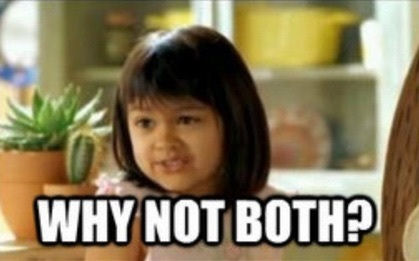
I decided that I would get my dough mostly made, divide it in half, add the ingredients that needed to be different in savory vs. sweet plăcintăs, and then make a half-batch of plăcintă cu mere (apple cakes) and a half batch of plăcintă cu brânză (cheese cakes, not to be confused with cheesecakes).
I’ve mentioned before that I’m not able to achieve perfect authenticity with all these recipes (nor am I trying to), and I departed a little bit from the perfectly authentic Moldovan recipes I found in both cases. When it came to the plăcintă cu brânză, the departure was both minor and necessary – the sort of cheese normally used for them in Moldova is also called “brânză” (which, somewhat unhelpfully, is just the Romanian word for “cheese,” although I think in this case it is probably the same thing as bryndza, a sheep milk cheese that Wikipedia tells me comes from Moldova and thereabouts). There wasn’t much chance of me finding Moldovan sheep milk cheese around here, but luckily, virtually every recipe I read noted that it tastes a lot like feta, so that was an easy substitution. As for the plăcintă cu mere, the departure was still fairly minor, but technically entirely unnecessary. You see, every recipe I found suggested that the apple filling should consist solely of apples, cinnamon, and ordinary white sugar. Which is nice and all, but I’m willing to eschew total authenticity in favor of adding some cloves, nutmeg, and brown sugar in there, too, because I love cloves, nutmeg, and brown sugar on apples. Mmm…cloves…
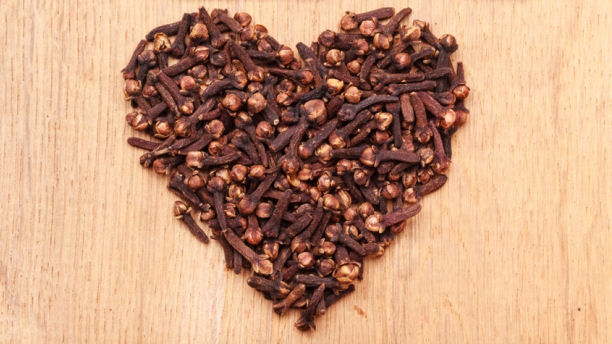
(Image source: Buzzle)
Okay, that’s enough nattering on about delicious cloves and toga-wearing placenta munchers. Let’s talk about…
THE PROCESS
As usual, I started by photographing my ingredients.
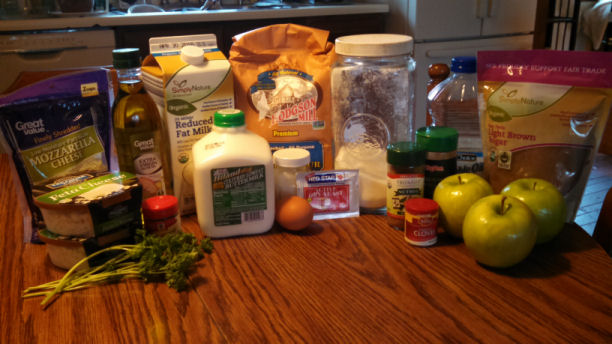
Next up was activating my yeast. A couple of the recipes I was working from called for buttermilk as the main liquid in my plăcintăs, but buttermilk isn’t the best liquid in which to activate yeast thanks to its added acidity, so I put the yeast in a little milk instead (with a teaspoon of sugar to make the yeast extra happy). Once the yeast was sufficiently activated, I stirred it in with the flour, salt, buttermilk, and egg in a large mixing bowl. At this point, I’d been hoping to go ahead and divide the dough so that I could use olive oil in the cheese plăcintă dough and plain vegetable oil in the apple plăcintă dough, but it wasn’t quite moist enough to pick up all the flour. So I decided to split the difference, and added one tablespoon of each, which made my main dough-ball just wet enough to be able to be divided properly. Once I’d split it in half, I added another tablespoon of the “correct” oil to each of the new, smaller dough-balls, and then added sugar (and a little more flour, to balance out the sugar’s stickiness – you just need enough to make sure the dough can be rolled into a smooth ball without sticking to your hands) to the dough for the apple plăcintăs. I then kneaded both blobs of dough for a bit, covered them up, and let them rise for 45 minutes or so. Then after a quick additional session of punching-down and kneading, I covered them back up and gave them another 45 minutes while I prepared my fillings.
Unfortunately, I sort of forgot that I was trying to write recipes here, and I didn’t do a particularly precise job of measuring how much of everything I put in the two fillings, but instead pretty much added things to taste. I’ll offer approximations and guesses as to the amounts in the ingredient lists at the end of this post, but if you try this recipe at home, I recommend taste-testing your own fillings and making them with whatever proportions strike your fancy.
First up was the apple filling. I peeled, cored, and chopped three nice tart Granny Smith apples and then tossed them in a saucepan on the stove with white and brown sugar (I probably would have used just the brown, but my “light” brown sugar seemed to be mislabeled, because once I opened the bag it became clear that it was noticeably darker and had a much stronger molasses flavor than typical light brown sugar), cinnamon, nutmeg, and cloves, and let that cook just long enough to soften the apples up a little.
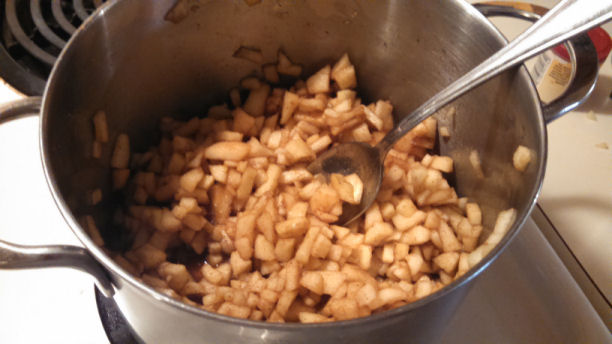
While that was cooking, I made my cheese mixture – mostly crumbled feta, but with a generous handful of shredded mozzarella (so I’d get good gooey meltiness inside my plăcintăs), along with the last of the good parsley left over from Week 2 and a spoonful of dried dill weed.
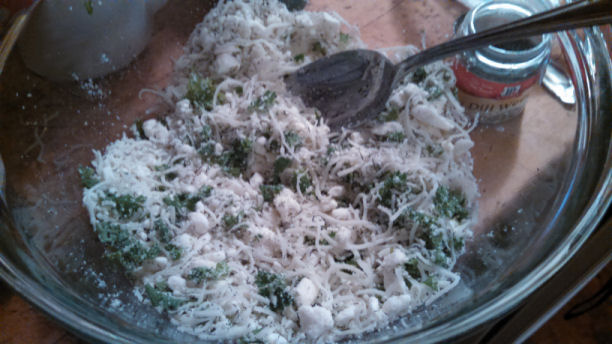
Once the fillings were done and the two balls of dough had roughly doubled in size, I divided each dough-ball into four roughly equal chunks, balled them up, and rolled them out into flat circles (okay, vaguely circle-ish shapes) around 6-8 inches in diameter. Each one then got a generous scoop of its appropriate filling in its center, like so:
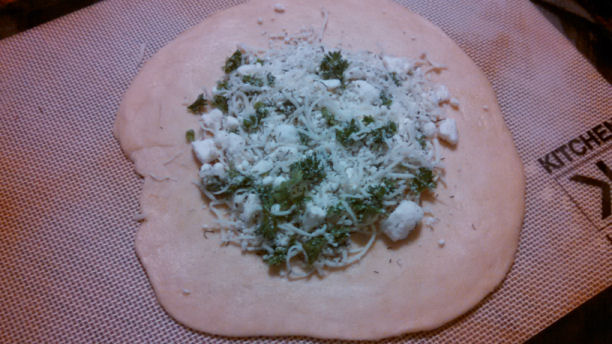
Then it was time for some Moldovan pastry origami. I folded down the top, bottom, and sides, then slightly folded in the corners.
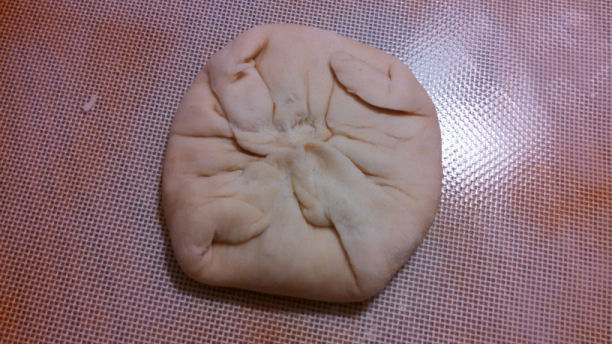
Then I used my fingers and the rolling pin (not at the same time, because that would hurt) to press those edges together as well as possible and flatten the whole thing out even more.
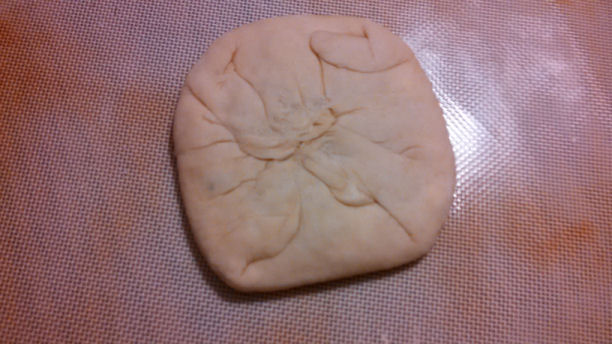
(Note: do not try smooshing the apple ones with the rolling pin unless you like apple explosions shooting out of your plăcintăs, since cooked apples contain a lot more moisture than uncooked cheese. Just smoosh them as well as you can by hand, and patch up any inadvertent applesplosion holes with spare bits of dough and a little cold water. They will be fine.)
You may notice that even with the rolling pin, I didn’t get the dough to adhere to itself perfectly. This meant that one side of my plăcintăs didn’t end up looking quite as nice as the other, but they still cooked up and tasted just fine.
Now, at this point, different recipes I found online suggested that the plăcintăs could be either baked or fried. I’m sure baking them would be nice, too, but (a) the sources I found that were unambiguously written by actual Moldovans tended to say to fry them, and (b) frying things is delicious. Frying it was!
I poured a few tablespoons of olive oil into a small frying pan and set the burner to low-to-medium heat. (My stove has numbers from 1-10 on the dials for the burners; I had the relevant dial set to just a smidge under “4.”) I put the first of my cheese plăcintăs into the pan and cooked one side of it until it was golden brown. I then flipped it over, splashed oil all over my hand, screamed in pain, and stuck my hand under cold water for a couple of minutes while feeling very, very grateful that I was using the aforementioned low-to-medium heat instead of a higher one. I highly recommend skipping that step and just flipping your plăcintăs more carefully. (My hand is okay now – definitely sore, but the lower cooking temperature and the distance the oil had to travel through the air before actually landing on me meant that I only ended up with pretty minor first-degree burns. It basically looks and feels like I sunburned random patches of my hand. But still, skip that step.)
Once I’d recovered enough to cook the other three cheese plăcintăs until they were all golden brown on both sides, I did the same thing (minus the burning myself) with another small frying pan, vegetable oil, and the apple plăcintăs. Once I was done, I had two sets of four plăcintăs, which looked like this on the outside:
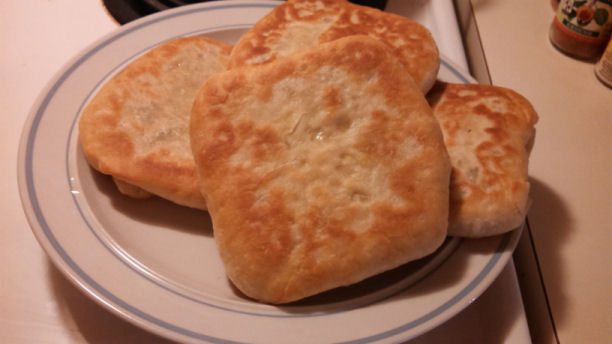
…and like this on the inside:
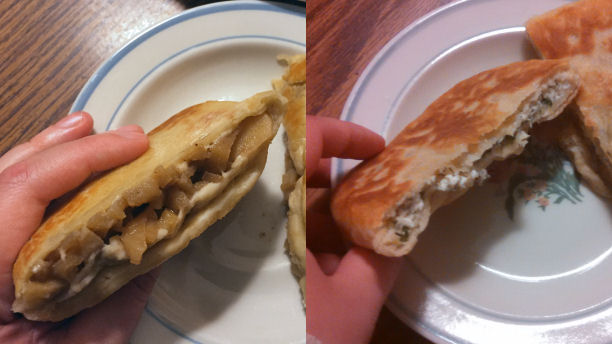
THE VERDICT
Pretty good!
The apple plăcintăs had a slight issue – because I couldn’t smash them down as much as the cheese ones, the “folded” side was noticeably thicker than the non-folded side (as you can see in the picture above), and thus the inner layer of dough on the thick side couldn’t get fully cooked in the frying pan without overcooking the outer layer of dough. This was pretty easily remedied by cooking the outsides appropriately and then sticking the sliced-open plăcintă halves in the microwave for a minute or so, but it would have been nice if they could have cooked more evenly in the first place. Truth be told, the apple ones weren’t anything special – it is nearly impossible for spiced apples and fried dough to taste anything other than yummy, and they did, in fact, taste yummy, but I already have an apple donut recipe that I love and which does the spiced-apples-and-fried-dough thing even better, so I can’t really imagine I’ll make apple plăcintăs again.
The cheese ones are another story. They are yummy in a much more distinctive way – the mix of mozzarella and feta worked exactly as I’d hoped (the feta absolutely dominates flavor-wise, but the mozzarella helped the filling get nice and melty), the dill makes it much more unique-tasting than cheese alone (or cheese and parsley) would have been, and it all works really well with the soft-but-flaky pastry exterior. I don’t know that I actually liked the cheese plăcintăs better than the apple ones, per se (like I said, apples and fried dough are pretty much inherently delicious), but I found them a whole lot more interesting. I think there’s a very good chance I’ll make them again (and hey, maybe I’ll still split the recipe in half and try yet another possible plăcintă filling next time, because I found recipes for at least five or six different types of plăcintă when I was doing my research for this week, and almost all of them sounded good).
THE INGREDIENTS
For the dough:
1 packet active dry yeast
1/3 cup milk
1 tsp sugar
3 cups flour
1 tsp salt
2/3 cup buttermilk
1 egg
4 tbsp oil (olive or vegetable oil, depending on what kind of plăcintăs you’re making), plus more for frying the plăcintăs
(For apple plăcintăs only:
1/4 cup sugar + enough additional flour to de-sticky-ify the dough)
For the apple filling:
3 tart apples
2-3 tsp (ish?) sugar
2-3 tsp (ish?) brown sugar
cinnamon to taste
nutmeg to taste
cloves to taste
For the cheese filling:
1 1/4 cups (ish?) feta cheese
1/2 cup (ish?) mozzarella
1/2 tsp dill
handful of fresh chopped parsley
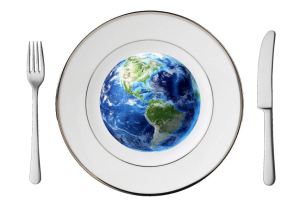
So, I’ve been to Moldova. Mamaliga is great to eat with something that is saucy or has gravy. It is otherwise bland, I agree 🙂 glad you tried both dishes, and happy to talk about my trips to various post soviet countries if you’re ever interested!
LikeLike
I’m absolutely interested! I’d already kinda figured I should poke you whenever I end up drawing Georgia out of the jar, but I didn’t remember offhand where else you’d been. 🙂
LikeLike
Georgia, russia, belarus, moldova, ukraine, finland, estonia, croatia (I’ve heavily been using a great croatian cookbook recently). A couple places in Europe too but those are more on the beaten path.
LikeLike
I’ll have to remember that list, and especially your Croatian cookbook! Also, two of your countries (Finland and Estonia) are actually on the (far too short) list of places outside the US I’ve been, too. Estonia in particular was fascinating, and I’d love to go back someday. I’ve been saying ever since I visited that there really ought to be a movie made about the Singing Revolution and especially the Baltic Way, because that’s such a cool bit of recent history, and most Americans seem never to have heard of any of it.
LikeLike
Agreed! I really liked both countries, not least because they say my name right there 🙂
LikeLike